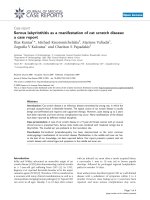Cat scratch fever Program SCRATCH
Bạn đang xem bản rút gọn của tài liệu. Xem và tải ngay bản đầy đủ của tài liệu tại đây (600.46 KB, 33 trang )
Cat Scratch Disease
and Other
Bartonella Infections
Cat Scratch Fever
Benign Inoculation Lymphoreticulosis
Benign Inoculation Reticulosis
Regional Granulomatous Lymphadenitis
Parinaud’s Oculoglandular Syndrome
Bacillary Angiomatosis
Overview
•
Organism
•
History
•
Epidemiology
•
Transmission
•
Disease in Humans
•
Disease in Animals
•
Prevention and Control
•
Actions to Take
Center for Food Security and Public Health, Iowa State University, 2012
THE ORGANISM
Cat Scratch Disease
•
Bartonella henselae
– Gram negative rod
– Formerly classified
as Rickettsia
•
Two major serotypes/genotypes
– Type I (Houston I)
– Type II (BA-TF/Marseille)
•
Bartonella clarridgeiae
Center for Food Security and Public Health, Iowa State University, 2012
Other Bartonellae
•
Bacillary angiomatosis, peliosis hepatitis caused by Bartonella spp.
– B. henselae
– B. quintana
• Non-zoonotic pathogen
• Carried by humans
•
Immunocompromised
individuals most commonly affected
Center for Food Security and Public Health, Iowa State University, 2012
Other Bartonellae
•
Dogs, coyotes, humans
– B. vinsonii subsp. berkhoffii
•
Humans, rodents
–
–
–
–
B.
B.
B.
B.
vinsonii subsp. arupensis
elizabethae
washoensis
grahamii
Center for Food Security and Public Health, Iowa State University, 2012
HISTORY
History
•
1950: Clinical syndrome described
•
1889: Similar disease reported
•
1983: Bacterial cause described
– Gram negative bacillus
– Found in lymph nodes of patients
•
1988: Organism successfully
isolated and cultured
Center for Food Security and Public Health, Iowa State University, 2012
History
•
1991: CSD bacillus named Afipia felis
•
1992: Rochalimaea henselae isolated
– Patients with bacillary angiomatosis
– Refuted role of A. felis in CSD
•
1993: Genera Rochalimaea
and Bartonella united
– B. henselae currently recognized
as causative agent of CSD
Center for Food Security and Public Health, Iowa State University, 2012
EPIDEMIOLOGY
Geographic Distribution
•
Worldwide
– B. henselae type I
• Eastern U.S.
• Asia
– B. henselae type II
• Europe
•
Temperate climates
– Seasonal variation
– Peak August to October (North)
Center for Food Security and Public Health, Iowa State University, 2012
Morbidity and Mortality
•
Humans
– 22,000 to 24,000 annual cases in U.S.
– 3 to 6% of general
population
seropositive
• Higher in veterinarians
– Most cases in children
•
Most infections self-limiting
•
Death is rare
Center for Food Security and Public Health, Iowa State University, 2012
Morbidity and Mortality
•
Seroprevalence in cats
– 14 to 55% in U.S.
– 40 to 70% in warm, humid climates
– 30% of captive wild felids
•
Higher in feral cats vs. pets
•
No reported morbidity or mortality
Center for Food Security and Public Health, Iowa State University, 2012
TRANSMISSION
Transmission in Animals
•
Vector-borne
– Cat flea (Ctenocephalides felis)
• Flea feces
– Ticks?
•
Other routes?
Center for Food Security and Public Health, Iowa State University, 2012
Transmission in Humans
•
Not well understood
•
Patient history usually includes:
– Cat scratch
– Cat bite
– Being licked by cats
•
Vector-borne (fleas)?
•
Exposure to other animals
– Other Bartonella species?
Center for Food Security and Public Health, Iowa State University, 2012
DISEASE IN HUMANS
Cat Scratch Disease
•
Usually mild, self-limiting
– Immunocompetent people
•
Initial skin rash
•
Lymph node enlargement
•
Fever, malaise, fatigue
•
Complications usually resolve
Center for Food Security and Public Health, Iowa State University, 2012
Cat Scratch Disease:
Complications
•
Parinaud’s oculoglandular syndrome
•
Encephalitis
•
Endocarditis
•
Disseminated disease
– AIDS patients
•
Rashes
•
Bone/joint lesions
•
Pneumonia
Center for Food Security and Public Health, Iowa State University, 2012
Bacillary Angiomatosis
and Bacillary Peliosis
•
Bacillary angiomatosis
– Vascular proliferative disease of
and/or internal organs
– Usually an AIDS-related disease
•
skin
Peliosis hepatitis
– Rare
– Blood-filled cysts and sinusoidal dilatation of
the liver
Center for Food Security and Public Health, Iowa State University, 2012
Diagnosis
•
History and physical examination
•
Culture
– Slow, specialized media required
•
PCR
– Can differentiate Bartonellae
•
Serology
– Indirect immunofluorescence
– ELISA
Center for Food Security and Public Health, Iowa State University, 2012
Treatment
•
Disease usually self-limiting
•
Treatment options
– Supportive care
– Lymph node excision
– Antibiotics
• Not consistently effective for CSD
• Useful for treatment of bacillary
angiomatosis caused by B. henselae
Center for Food Security and Public Health, Iowa State University, 2012
DISEASE IN ANIMALS
Species Affected
•
Cats, felids are reservoir hosts
•
Experimental infection
– Dog
– Armadillo
– Mice
Center for Food Security and Public Health, Iowa State University, 2012
Disease in Cats
•
Often asymptomatic
•
Possible clinical manifestations
– Lymphadenopathy
– Kidney disease
– Ocular disease
•
Experimental infections
– Equivocal
Center for Food Security and Public Health, Iowa State University, 2012









